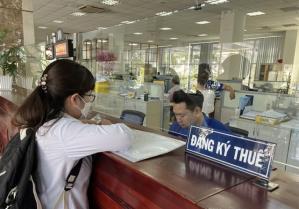A large wave of closures is prompting renewed scrutiny of Việt Nam’s bankruptcy law, as many argue that the current framework neither reflects market realities nor provides an effective safety net for struggling firms.

Compiled by Hoàng Anh
In an increasingly competitive economic climate, more than 58,000 Vietnamese enterprises withdrew from the market in January alone — a trend that has become a growing concern among policymakers.
According to the General Statistics Office, over 52,000 of those firms only suspended operations temporarily, yet the scale of the issue is large. On average, about 26,300 businesses ceased operations each month in the first quarter of 2025.
Under the 2014 Law on Bankruptcy, an enterprise that fails to meet its debt obligations within three months of the due date may be declared bankrupt. The process is clearly defined on paper — from filing and acceptance to potential recovery and final declaration. Yet while the law sets out a procedural path, its application in practice tells a different story.
Between 2015 and 2023, courts nationwide handled only about 1,500 bankruptcy cases, a tiny fraction compared with the hundreds of thousands of businesses that stop operating each year. Of those, only 150 were formally declared bankrupt, and just six entered a recovery process.
The numbers highlight a deeper reality: most enterprises simply shut down quietly, bypassing legal resolution or rehabilitation. Analysts say the current system is too complex and time-consuming, and offers little chance of genuine recovery.
At a recent meeting of the National Assembly (NA)’s working group on the amended Law on Bankruptcy, Vice Chairman of the National Assembly Lê Minh Hoan proposed a shift in perspective to view bankruptcy not as an end, but as an opportunity for renewal.
Drawing on international practice, he noted that in many economies, firms deliberately file for bankruptcy as a step toward restructuring and restarting operations.
“It should not be that once a business is clinically dead, it is dead forever,” he said. “We should look at bankruptcy as part of the business life cycle, a moment for renewal rather than termination.”
Hoan suggested that the law’s title itself be changed to 'Law on Recovery and Bankruptcy', signalling a more humane, supportive and forward-looking approach.
“The law should carry a spirit of partnership between the State and enterprises, helping reduce risks and encouraging a culture of legitimate failure and rebirth,” he said. Properly handled cases of bankruptcy, he added, could even serve as examples — showing that failure, when managed responsibly, can be a pathway to progress.
Reform with caution
NA Vice Chairman and Senior Lieutenant General Trần Quang Phương endorsed the proposed renaming, while emphasising the need for simplified and faster procedures.
“The problem is how to design a process quick enough to handle such enterprises efficiently,” he said. His comments reflected a pragmatic counterpoint to the more optimistic vision of his colleague.
He cautioned that recovery should remain the enterprise’s choice, not a State-imposed requirement.
“The law should provide legal support, not expand State power to force recovery or liquidation — unless the business operates in sectors of strategic importance,” he noted.
NA deputy Nguyễn Minh Sơn of Đồng Tháp Province shared this concern, pointing out that the handling of bankrupt enterprises has been slow and inefficient. “This amendment is necessary to accelerate the process and to deal with businesses that are effectively ‘dead but unburied’,” he said.
The NA’s Economic and Financial Committee reported that, while the 2014 law already includes provisions for recovery, implementation has been hampered by a lack of clear procedural guidance. This institutional bottleneck underscores why several lawmakers believe a new framework is urgently needed. Renaming and restructuring the law, they said, could help clarify the practical link between bankruptcy and recovery.
Economists added that the new provisions would introduce a structured rescue framework within the law, aligning with international standards and economic logic to prevent moral hazard. The aim is to create a balanced system that encourages timely restructuring while protecting creditors’ rights. This approach would align Việt Nam’s bankruptcy regime more closely with modern economic pragmatism.
Nevertheless, several delegates have voiced caution. They warned that if recovery mechanisms are misused to delay genuine bankruptcy, they could lead to asset losses and undermine creditor confidence. The proposed use of public funds to cover recovery-related costs also raises concerns about fiscal burden and accountability.
“The law must carefully define eligibility, supervision and financial responsibilities,” one delegate said. “Otherwise, recovery could become an excuse for postponing liquidation, increasing systemic risk.”
Observers agree that the success of the amended law will depend on effective enforcement — how courts, creditors and regulators coordinate to ensure both efficiency and integrity in implementation. Without robust oversight, even the best-intentioned reforms could falter.
Beyond technical revisions, the debate signals a broader evolution in Việt Nam’s economic thinking. Economists said for decades, bankruptcy has carried the stigma of failure — a final, negative judgment.
The proposed amendments suggest a new philosophy: that failure is part of growth, and that the legal system should facilitate legitimate recovery rather than simply close doors. It also reflects Việt Nam’s maturing market mindset, as policymakers seek to align business laws with global norms of transparency, accountability and second-chance entrepreneurship.
If successfully implemented, the new law could reshape the business environment, encouraging openness, strengthening creditor confidence and allowing entrepreneurs to re-enter the market more quickly after failure.
By redefining bankruptcy as renewal, Việt Nam moves toward a more resilient and forgiving economic ecosystem, one that values perseverance as much as success. VNS





